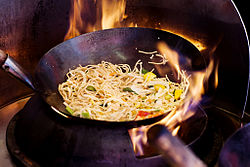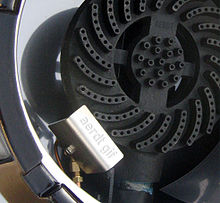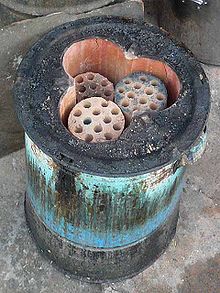Wok
![]()
This article or section is still missing the following important information:
Typical dishes, history
Help Wikipedia by researching and adding them.
![]()
The title of this article is ambiguous. For other meanings, see Wok (disambiguation).
A wok (Chinese 炒鍋 / 炒锅, pinyin chǎoguō, Jyutping caau2wo1, abbreviated 锅 / 鍋, guō, Jyutping wo1) is a tall, continuously curved pan that is one of the most important cooking utensils in Chinese and South and Southeast Asian cuisine. In many cases, it is a universal cooking utensil that can be a pot, skillet, steamer, deep fryer, and other cooking utensils on the heat source. It is known as wadjan in Indonesia, kuali in Malaysia, and kawali (small wok) and kawa (large wok) in the Philippines. Also similar is the Indian karhai (also kadhai or karahi, Hindi कढाई kaṛhāī), but it has a flat bottom. The name wok (鑊 / 镬, huò, Jyutping wok6) comes from Cantonese.

A wok on a flame

Flaming wok

Modern burner of a wok or Chinese stove
Description
Characteristically, unlike Western pans and pots, there is no difference between the bottom and the wall of the wok - the whole vessel is shaped as a spherical cap. Traditionally, woks have two opposing handles, one of which is often a handle. Woks are traditionally used on small, open-top coal stoves (nowadays usually special gas burners or electric cookers), on whose opening they have good stability and can be heated strongly with little fuel. The heat is concentrated particularly in the centre, so that the desired temperature range can be selected by moving the food to be cooked. Woks are used in many ways for frying, stewing, deep-frying, braising, boiling, blanching, smoking, roasting and steaming. The most important cooking method is "stir-frying", also called "sautéing", in which the ingredients are briefly sautéed and quickly cooked under constant movement.
Woks are traditionally made of cast iron, but today they are also made of sheet steel, carbon steel, stainless steel or aluminium. Simple woks made of sheet steel are pressed or drawn from sheet metal, high-quality brought into shape with a hammer. The diameter ranges from about 30 centimetres to over a metre.
For western households that do not have special cooking areas for woks, woks with a flattened bottom, sometimes with a non-stick coating, are offered that are also suitable for common electric and gas stoves, sometimes also for induction stoves.
However, common Western electric hotplates and gas stoves do not develop the power of dedicated wok stoves, which usually have a maximum power above five to ten kW, while the power of Western cookstoves rarely exceeds 2.2 kW or 3.6 kW for gas stoves. In addition, the heat of the wok burner with the upward flowing hot air also distributes to the outer wall, while an electric stove only heats the bottom of the wok. Modern restaurant and commercial kitchens in China use special induction cooktops to heat the wok. A cooking appliance that looks like a wok, heated on a flat hob and with an internal coating, will never produce the result of a "real" wok at powers of less than 5 kW, but only that of a pot with a curved bottom.
In western kitchens, the use of a wok on a suitable stove only seems to make sense for "stir-frying". Here, the high preparation temperatures and the preparation method are necessary for the special aroma of the food (see Wok-Hei). Other types of preparation, which usually also require lower temperatures, can be done in cooking utensils, as they are kept in a western kitchen.
However, a wok can very usefully replace a deep fryer if a dedicated appliance is not available.
Woks that are traditionally used on hobs with high power and heat are usually not provided with special coatings, as these cannot withstand the high temperatures. A non-stick coating is also not necessary if the wok has been "burnt in" before first use. This is done after thorough cleaning by heating to approx. 300 °C (blue tempering colour) and then rubbing with a suitable oil (e.g. peanut oil). A well-baked and used wok is cleaned exclusively with hot water (without additives) and a broom made of bamboo strips. Subsequent oiling (again, e.g. peanut oil) prevents rust.
Also, most foods do not burn in the wok because the protein responsible for burning denatures very quickly due to the high heat, creating a "natural non-stick coating".

Traditional wok warmer with (here burnt down) hard coal briquettes
Wok-Hei
Wok-hei, also: wokhei (鑊氣 / 镬气, huòqì, Jyutping wok6hei3) or guoqi (鍋氣 / 锅气, guōqì) describes the taste, smell, and aroma imparted to a food when it is prepared in a wok under the influence of high temperatures above the 200 °C limit. The term can be translated as "wok aroma". In order to achieve the special flavor, the food must be stirred in a baked wok under constant motion and cooked in a very short time. From a chemical point of view, the processes of caramelization and Maillard reactions are responsible for Wok-Hei.
Search within the encyclopedia